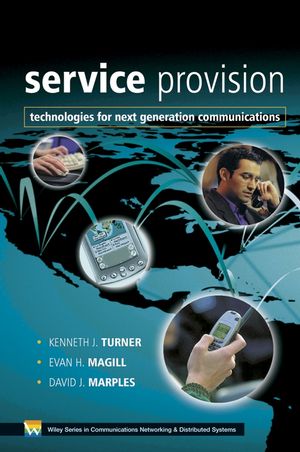Service Provision: Technologies for Next Generation CommunicationsISBN: 978-0-470-85066-4
Hardcover
360 pages
May 2004
 |
||||||
Preface.
PART I: NETWORK SUPPORT FOR SERVICE.
1. Introduction and Context (Kenneth J. Turner, Evan H. Magill and David J. Marples).
1.1 Communications Services.
1.2 Network Support for Services.
1.3 Building and Analyzing Services.
1.4 The Future of Services.
2. Multimedia Technology in a Telecommunications Setting (Alistair McBain).
2.1 Definition of Multimedia.
2.2 Market Drivers for Multimedia.
2.3 Standards for Multimedia Services.
2.4 Multimedia Services and their Constituent Media Components.
2.5 Interworking between Multimedia and Traditional Voice.
2.6 Terminal Equipment and User Interfaces.
2.7 The Future.
3. Call Processing (Graham M. Clark and Wayne Cutler).
3.1 The Beginnings of Call Processing.
3.2 Key Attributes of Call Processing Systems.
3.3 Switch Architectures and Call Models.
3.4 Switch-Based Services.
3 . 5 Call Processing for Intelligent Networks.
3.6 Softswitches.
3.7 Future.
4. Advanced Intelligent Networks (Robert Pinheiro and Simon Tsang).
4.1 History of the Intelligent Network (IN/AIN).
4.2 Intelligent Network Architecture.
4.3 Components of IN Service Delivery.
4.4 Intelligent Network Services.
4.5 Assessment of Intelligent Networks.
4.6 Future of Intelligent Networks.
5. Basic Internet Technology in Support of Communication Services (Marcus Brunner).
5.1 Introduction.
5.2 Transport Service Quality in the Internet.
5.3 Internet Telephony.
5.4 Directory-Enabled Networks (DEN).
5.5 Open Services Gateway Initiative.
5.6 Active Networks.
5.7 Conclusion.
6. Wireless Technology (James M. Irvine).
6.1 Introduction.
6.2 Cellular Systems.
6.3 Private Mobile Radio.
6.4 Broadcast.
6.5 Local wireless.
6.6 The Future of Wireless.
PART II: BUILDING AND ANALYZING SERVICES.
7. Service Management and Quality of Service (Pierre C. Johnson).
7.1 Overview.
7.2 What is Service Management?
7.3 Service Level Agreements.
7.4 Quality of Service.
7.5 Further Reading.
8. Securing Communication Systems (Erich S. Morisse).
8.1 Introduction.
8.2 Cryptosystems.
8.3 Authentication.
8.4 Access Control.
8.5 Security in Practice – Digital Cash.
8.6 Future.
8.7 Further Reading.
9. Service Creation (Munir Cochinwala, Chris Lott, Hyong Sop Shim and John R. Wullert II).
9.1 Overview.
9.2 Introduction.
9.3 Services in the Public Switched Telephone Network.
9.4 Internet-Based Data and Communication Services.
9.5 Integrated Services.
9.6 Service Introduction.
9.7 Conclusion.
9.10 Further Reading.
10. Service Architectures (Gordan S. Blair and Geoff Coulson).
10.1 Introduction and Motivation.
10.2 Early Developments.
10.3 Current Architectures.
10.4 Applying the Technologies.
10.5 Meeting Future Challenges.
10.6 Conclusion.
11. Service Capability APIs (John-Luc Bakker and Farooq Anjum).
11.1 Introduction.
11.2 Telecommunications Information Network Architecture.
11.3 Java APIs for The Integrated Network.
11.4 The Parlay APIs.
11.5 X Web Services.
11.6 Conclusion.
11.7 Further Reading.
12. Formal Methods for Services (Kenneth J. Turner).
12.1 What is a Formal Method?
12.2 Classification of Formal Methods.
12.3 Formal Methods for Communications Services.
12.4 Formal Methods for Telecommunications Services.
12.5 Evaluation of Formal Methods for Services.
13. Feature Interaction: Old Hat or Deadly New Manace (Evan H. Magill)?
13.1 Overview.
13.2 Introduction.
13.3 Feature Interaction in POTS.
13.4 Response of the Communications Community.
13.5 Regulatory Changes.
13.6 Technological Changes.
13.7 Future Services, Old Interactions.
13.8 Future Services, Future Interactions.
13.9 Future Services, More Complex Interactions.
13.10 New Challenges, New Opportunities.
13.11 Summary.
PART III: THE FUTURE OF SERVICES.
14. Advances in Services (James T. Smith).
14.1 Introduction.
14.2 Service Convergence.
14.3 Context: Putting Communications in Perspective.
14.4 Context: The next Killer Service Feature.
14.5 Sharing Service Context.
14.6 SIP: The Oil that makes Context Flow.
14.7 Discovering Service Context.
14.8 The New Converged Home Network.
14.9 Conclusion.
15. Evolving Service Technology (Peter Martin and Stephen Corley).
15.1 Introduction.
15.2 Software Agents.
15.3 Constraints Satisfaction.
15.4 Artificial Neural Networks.
15.5 Genetic Programming for Service Creation.
15.6 Conclusions.
15.7 Further Reading.
16. Prospects (David J. Marples, Kenneth J. Turner and Evan H. Magill).
16.1 Introduction.
16.2 Technical Challenges.
16.3 Service Environments.
16.4 Market Changes.
16.5 Commercial Changes.
16.6 And Finally…
Appendix 1. Abbreviations.
Appendix 2. Glossary.
Appendix 3. Websites.
Bibliography.
Index.



